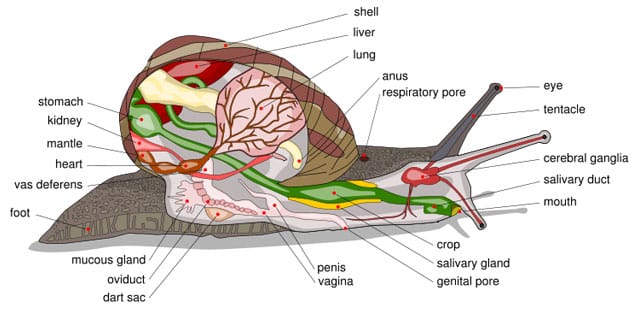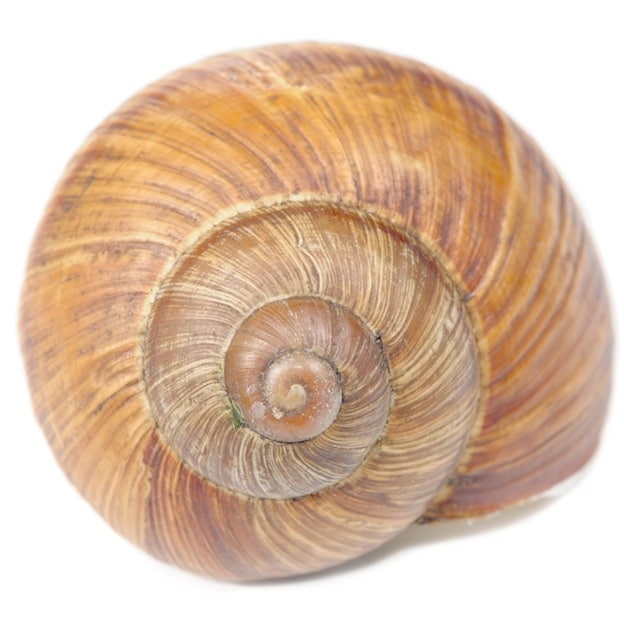Basic Land Snail Anatomy
The anatomy of a land snail is very different from many other animals in the world. Some people find them to be fascinating while others think they are pretty ugly. When you start to break down all of the parts of the body though they definitely have an interesting anatomy and physiology.
The shell of a land snail can be very different in size and shape depending on the species of snail it is. Some of them are coned while others are flatter. However, all of them have a spiral design to them, caused by the way land snails produce and growth their shells.
Shells serve as a way to protect snails from the environment and even from predators in some cases. However, many predators are able to bite through the hard shells with powerful teeth and jaws.
The shell of a land snail is made up of calcium carbonate. The shell becomes very strong and remains that way as long as the snail consumes a diet that is full of calcium. Without it the shell will start to crack. Since the rest of the body is very soft and slimy, they must have a hard shell if they are going to survive the elements in the world around them.
While moving, snails they leave behind a trail of mucus. This mucus acts as a powerful lubricant to reduce friction against the surface. This is why they are able to move upside down, around corners, and other situations.
Body parts of a land snail.
It is a myth that this mucus is going to make humans ill. Many people worry that snails being in their garden will ruin the foods grown there and make them unfit for consumption but that is all false.
They shell is a safe haven for the snails to reside in. When they sense danger around them, putting the whole body into the shell is their line of defense. You will also find that snails spend a great deal of time in their shell when the weather is very hot and dry. Otherwise their moist bodies will dry out.

Image under GNU license.
Author Original by Wikimedia Commons User Al2, English captions and other edits by Jeff Dahl
Snails have one or two sets of tentacles that are on top of the head. The number of pairs will depend on the species you are describing. For species with both sets of tentacles, you will find that the eyes are present on the longer set and smell in the shorter set. You may not always see these tentacles though as all land snails have the ability to retract them.
The snail has a very small cerebral ganglion that is known to have four distinct sections on it. Although this is a rudimentary brain, they have more ability for associative thinking than most people give them credit for. Some research shows that they do take part in associative thinking, which is based on conditioning and experiences that they take part in. (1)
The mouth of a snail is found at the bottom of the head, in close proximity to the tentacles.
Most land snails have a lung, so they breathe air. To do it, they breathe through a cavity called the visceral. There are many blood vessels here and the function is the same as what our lungs are able to do for us.
There is a foot on land snails, which allow them to move forward. There is contracting and expanding in this muscle that allow them to have movement. To make this movement smoother and to avoid injuries, land snails produce mucus to help the foot slide.

Beautiful Snail Shell
A gland in the foot produces the mucus that they glide along. Without this mucus under them, the environment would be too hard for their soft bodies to move along without injury.
Covering the foot and some internal organs there is a protective layer called the mantle. In some cases, it is also found around the shell to offer it additional protection. The mantle make the shell grow by delivering the secretions that will add to the shell.
If you watch how a snail looks before moving you will notice what appear to be spasms through them and then they inch forward. These are the muscles in the foot working. Even though they do move slowly there is a rhythm to it that they will follow over and over again. This can be fascinating to watch.
(1) http://www.telegraph.co.uk/lifestyle/9433231/Germaine-Greer-Snails-deserve-our-attention.html
(2) https://insects.tamu.edu/extension/publications/epubs/eee_00026.cfm
Sem comentários:
Enviar um comentário